Lava Xolo X900 Review - The First Intel Medfield Phone
by Brian Klug on April 25, 2012 6:00 AM ESTBattery Life
Nailing performance is one thing, but in order to really sell Medfield and other upcoming SoCs to OEMs, Intel has to deliver battery life and power consumption that's competitive. It's about performance/power in the SoC space. First, it's worthwhile to note that the X900 includes a relatively small battery, at just 5.4 Whr. Of late, batteries over 6 Whr seems like the norm, and I'm told that future designs including the Motorola phone will probably include larger ones. It's just good to have that frame of reference and this chart should help:
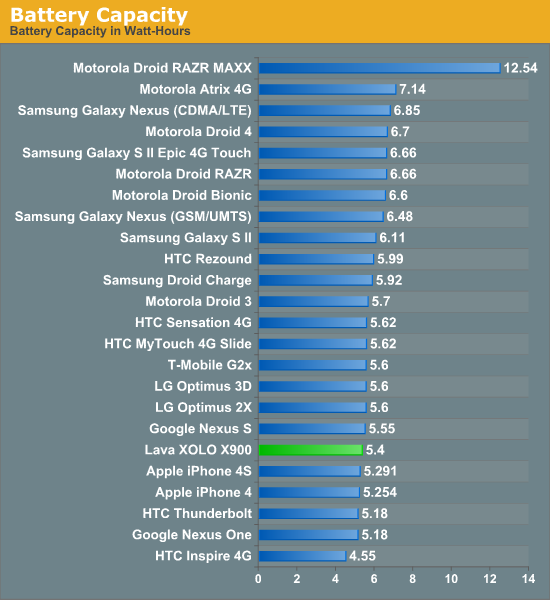
Intel notes battery life in their own X900 announcement blast as being around 5 hours of continuous 3G browsing and 8 hours of talk time. Our own numbers end up being pretty darn close, at 4.6 hours and 8.5 hours for those two metrics, respectively.
As a reminder, the browsing tests happen at 200 nits and consist of a few dozen pages loaded endlessly over WCDMA or WiFi (depending on the test) until the phone powers off. The WiFi hotspot tethering test consists of a single attached client streaming 128 kbps MP3 audio and loading four tabs of the page loading test through the handset over WCDMA with the display off.
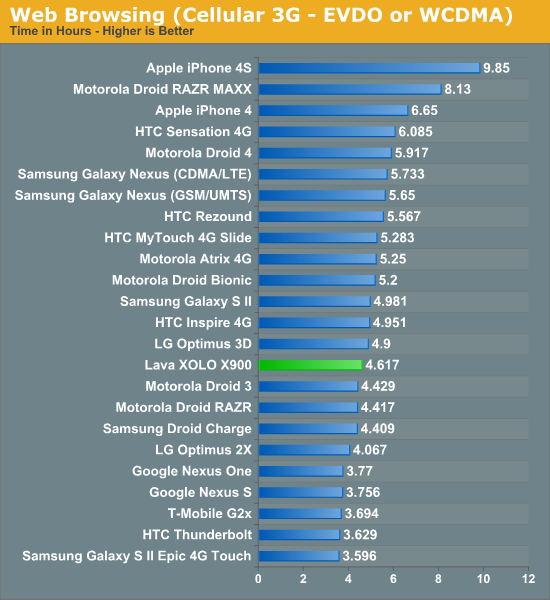
As a smartphone the X900 does a bit below average here, but as we mentioned it also has an unusually small battery for a modern flagship Android smartphone. If we divide battery life by battery capacity, we can get a better idea for how the Medfield platform compares to the competition:
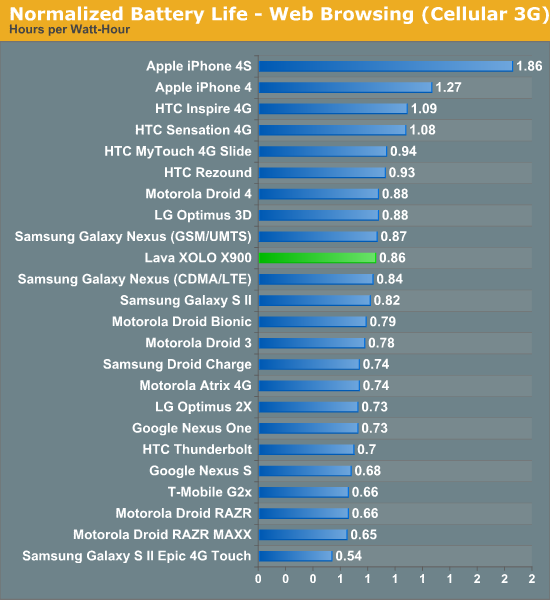
Normalizing for battery capacity, the X900 actually does a bit above average. In other words, the Medfield platform appears to be just as power efficient as some of the newer OMAP 4 based smartphones.
On WiFi the situation is no different:
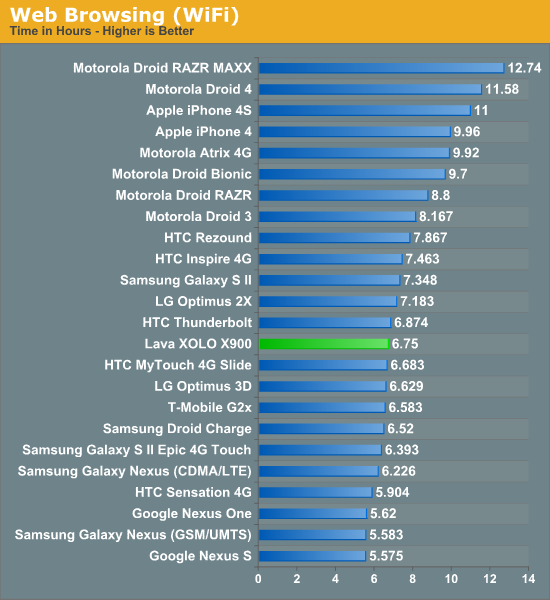
Again we see reasonable numbers for the X900 but nothing stellar. The good news is that the whole x86 can't be power efficient argument appears to be completely debunked with the release of a single device. To move up in the charts however, Intel needs to outfit its reference design with a bigger battery - something I've heard is coming with the Z2580's FFRD. The normalized results put the X900 at the middle of the pack:
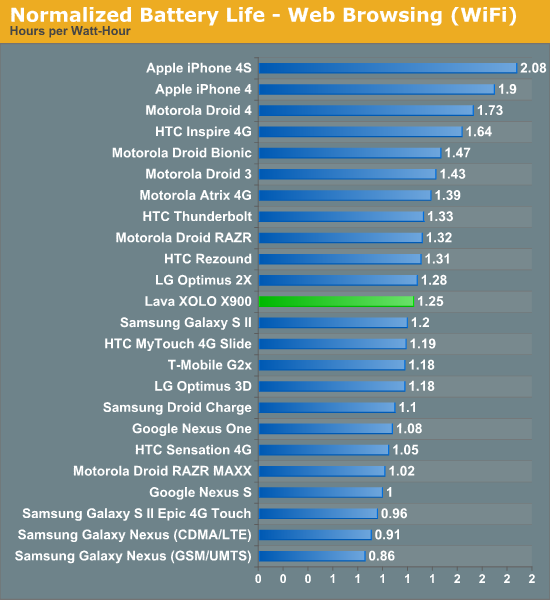
We see similar results in our talk time and 3G hotspot tests:

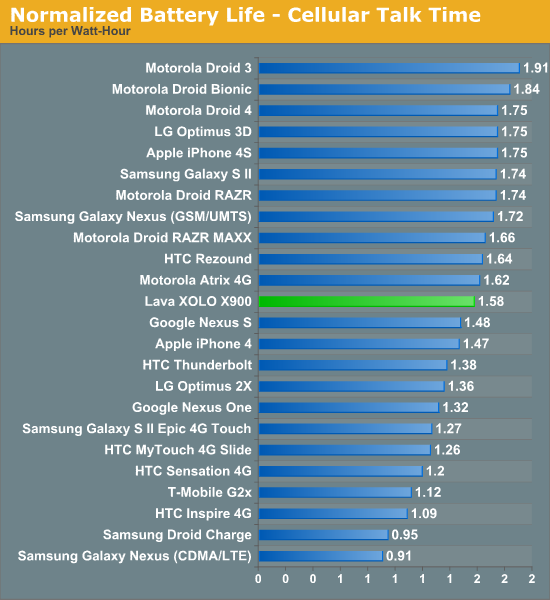
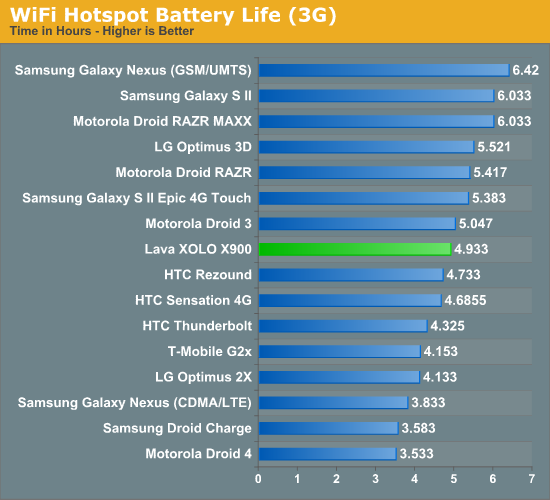
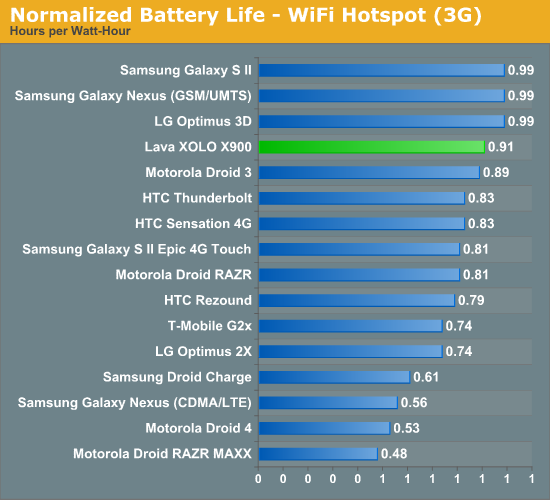










106 Comments
View All Comments
vol7ron - Wednesday, April 25, 2012 - link
I doubt windows would expect PCI channels lol. Though, it might need drivers to operate.Everything you need is on the phone for windows to operate (Screen, CPU, Video, RAM and Disk space) exists, even though Windows doesn't require it all. Though, Windows does need some way to communicate with those devices (device drivers), which Win7/etc probably doesn't have.
Shadowmaster625 - Wednesday, April 25, 2012 - link
A few years from now it is likely I might be able to acquire one of these for dirt cheap. (Broken screen, etc) I would use it just for an ultra low power ultra low profile *single-function* pc. I would very much like to know if this hardware can run windows 7. It doesnt need to run well, it just needs to be able to go on the web and do basic things similar to an atom nettop.superPC - Wednesday, April 25, 2012 - link
it won't run windows 7. unlike windows 8, windows 7 requires standard RAM not LPDDR. windows 7 also requires some form of PCI.Musafir_86 - Wednesday, April 25, 2012 - link
-Excuse me, but IMHO, the type of physical RAM shouldn't matter. If not, we couldn't be able to load these OSes on VMs at all. :)Regards.
B3an - Thursday, April 26, 2012 - link
Why would you even want to run Win 7 on this when Win 8 would clearly be WAY better suited, not to mention it also uses less resources and RAM while remaining faster/snappier than 7.rahvin - Friday, April 27, 2012 - link
I'd imagine he wants to know because Windows 8 is going to be only slightly less successful than Vista. Personally I'd guess around 5% of the Vista sales. It's a disaster in waiting unless they make dramatic last minute changes. You should try using it.joshv - Wednesday, April 25, 2012 - link
I am not sure why this chipset matters. Intel usually wins on x86 compatibility with older software. In the phone space there is no existing x86 code, and in fact they are stuck emulating another ABI - so they will be slower and less efficient that competitors that implement that ABI natively.That leaves Intel to compete on price/performance alone in a market where their competitors have 99.9% of the market. An odd position for Intel.
Perhaps this makes more sense in a Windows 8 tablet?
Impulses - Wednesday, April 25, 2012 - link
Its netbooks all over again, on a much bigger scale. ARM is moving upscale, if Intel doesn't start competing directly they will eventually start ceding some existing market share (when tablets/laptops start to overlap more, and the writing's on the wall with Windows for ARM).Only difference is they're up against a capable rival(s) as opposed to a limping AMD, so they can't just come out of the gate strong and them dog it and let the lower end market stagnate in order to maintain profits.
This is a small first step but it'll allow them to ink more deals and possibly cement a strong foundation for upcoming Win8 ARM tablets which is probably their bigger long term concern.
dcollins - Wednesday, April 25, 2012 - link
Did you even read the article?The x86 vs ARM issue is mostly a non-issue that will be completely resolved within a few months. Dalvik apps are JIT compiled to ARM and x86 and will perform similarly. In fact Intel might have an advantage here because they have the best compiler engineers in the world with decades of experience in generating high performance x86 code. NDK apps will generally be supported natively; developers only have to check a box to include x86 binaries. Even Apps that aren't compiled with x86 support are translated prior to installation on the users device. Nothing about the instruction set makes Medfield slower than ARM.
Performance today is comparable to modern ARM processors even when running an out of date, slower OS. Performance in 4.0.x should match or outperform even Krait. Graphics performance is middle of the road, but that's a major concern for many smartphone buyers (myself included). Even in benchmarks that purposefully stress mutliple cores, Medfield holds its own against the many cored competitors. Real world usage is more lightly threaded.
Browser performance is the most important metric for my usage and here Intel performs extremely well. If Medfield is available in a 4.x phone when it comes time for me to upgrade, I will seriously consider it versus a Krait based offering. Now imagine a next generation Atom build on 22nm with dual core, hyperthreading and possibly OoO execution: that chip will eat A15s for breakfast.
dcollins - Wednesday, April 25, 2012 - link
edit: "Graphics performances... is NOT a major concern"